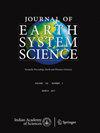关于 Koh-i-Noor 和其他 Golkonda 钻石的可能原始来源
摘要
Koh-i-Noor 和其他世界著名的钻石,如 Hope、Orloff、Great Mogul、Nizam 和 Pitt,在业内被称为 "Golkonda Diamonds",因其罕见的颜色和大克拉尺寸而广为人知。这些闻名遐迩的戈尔康达钻石是从印度南部克里希纳河岸的块矿中开采出来的,但是,它们的原生岩(金伯利岩或灯石岩)仍然受到质疑,无法找到。要了解这些大尺寸、主要为 IIa 型钻石(即 CLIPPIRS)的深地幔起源、岩浆活动的性质和时间,准确鉴定其主要来源至关重要,从经济和地质学角度来看也至关重要。我们采用了多学科方法,包括异晶矿物成分和块岩地球化学、野外地质和遥感(GIS)研究,以确定这些著名钻石的可能主要来源,了解印度南部 IIa 型 Golkonda 钻石的起源,并了解钻石在克里希纳河流域作为块岩迁移和散布的机制和时间。我们的研究排除了东达尔瓦克拉通(Eastern Dharwar Craton)和班加纳帕勒(Banganapalle)砾岩中的各种灯石矿点是 Koh-i-Noor 和其他戈尔康达钻石来源的可能性。瓦杰拉卡鲁尔(Wajrakarur)的晚白垩世金伯利岩中没有含钻石量高的 IIa 型钻石,这同样排除了这些金伯利岩是戈尔康达钻石来源的可能性。在印度南部两个重要的金伯利岩场,即瓦杰拉卡鲁尔金伯利岩场和纳拉扬佩特金伯利岩场中,瓦杰拉卡鲁尔金伯利岩场(WKF)的指示矿物成分揭示了它们最终的钻石保存潜力,存在强大的含钻地幔根系和更深的源区,因此被认为是戈尔康达钻石的潜在来源。利用地理信息系统(GIS)和遥感工具计算了含水量和植被指数,并确定了彭纳河古河道的位置,该河道主要负责将钻石从瓦杰拉卡鲁尔的中新生代(约 1.1 Ga)源岩运送到最终的开采地点,即克利须那河畔的科鲁鲁和其他矿场。克里希纳河排水系统中的冲积块矿床与南非的奥兰治河排水系统类似。这两个地区的钻石都来自原生金伯利岩管,经河流搬运后沉积在特定区域。克里希纳河和奥兰治河冲积矿床在钻石的来源、运输、扩散和沉积机制方面的相似性,对钻石的大量生产起到了至关重要的作用。

Koh-i-Noor and other world-famous diamonds such as Hope, Orloff, Great Mogul, Nizam, and Pitt, well-known in the industry as ‘Golkonda Diamonds’ are very well recognised for their rare colours, large carat sizes, and because of the paucity of nitrogen atoms majority of them have been classified as Type IIa diamonds. These renowned Golkonda diamonds were recovered from placers mined on the banks of the Krishna River in southern India; however, their primary source rocks (either kimberlites or lamproites) remain questioned and untraced. Precise identification of the primary sources of such large-sized, dominantly Type IIa diamonds (i.e., CLIPPIRS) is crucial for understanding their deep mantle origin, nature and timing of magmatism carrying them and essential from economic and geological perspectives. We employed a multidisciplinary approach incorporating xenocrystic mineral composition and bulk-rock geochemistry, field geological and remote sensing (GIS) studies to locate the probable primary sources of these renowned diamonds, know the origin of Type IIa Golkonda diamonds in southern India, and to understand the mechanism and timing of diamond transport and dispersal as placers in the Krishna River basin. Our study rules out the possibility of various lamproite occurrences of the Eastern Dharwar Craton and Banganapalle conglomerates as being sources of Koh-i-Noor and other Golkonda diamonds. The absence of Type IIa diamonds in the highly diamondiferous Late Cretaceous kimberlites of Wajrakarur likewise excludes them as source of Golkonda diamonds. Among southern India's two significant kimberlite fields, i.e., Wajrakarur and Narayanpet, compositions of indicator minerals from the Wajrakarur Kimberlite Field (WKF) reveal their ultimate diamond preservation potential, presence of strong diamondiferous mantle roots and deeper source regions, hence recognising them to be the potential sources of Golkonda diamonds. GIS and remote sensing tools were used to calculate moisture content, vegetation indices, and to locate paleo-channel of the Penner River, which was primarily responsible for the transportation of diamonds from their Mesoproterozoic (ca. 1.1 Ga) source rocks at Wajrakarur to their final sites of recovery, i.e., Kolluru and other mines situated on the banks of the Krishna River. The occurrence of alluvial placer deposits in Krishna River drainage system is analogous to the Orange River drainage system in South Africa. Both areas have diamonds sourced from primary kimberlite pipes, transported by rivers, and deposited in specific areas. Similarities in the origin, mechanism of diamond transport, dispersal and deposition have played a crucial role in significant diamond production from alluvial deposits in Krishna and Orange Rivers.

 求助内容:
求助内容: 应助结果提醒方式:
应助结果提醒方式:


